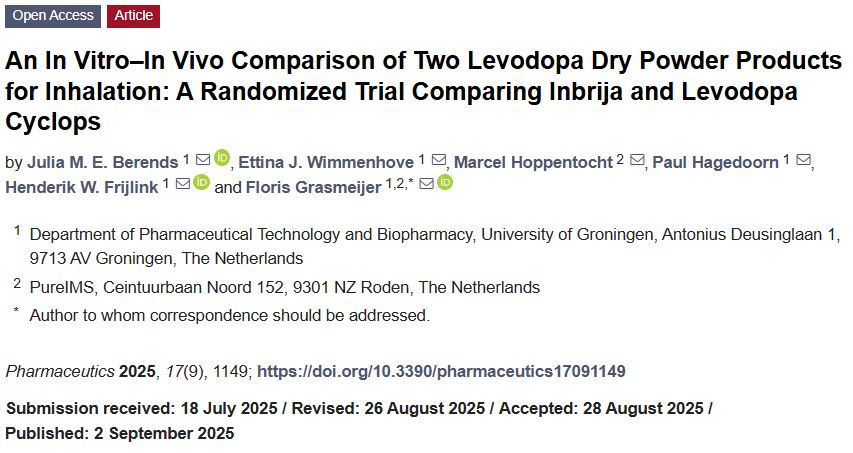Full paper: Pharmaceutics 2025, 17(9), 1149; https://doi.org/10.3390/pharmaceutics17091149
Background/Objectives:
The pulmonary administration of levodopa enables a rapid absorption and onset of action, making it a suitable administration route for managing OFF episodes in Parkinson’s disease. Currently, one dry powder product for inhalation (Inbrija) is available on the market, while another (Levodopa Cyclops) is in development. These two products differ substantially in terms of inhaler design, their use and resistance, and their powder formulations. This study aimed to investigate whether these differences translate into in vitro differences in aerosol characteristics and dissolution kinetics and whether any differences were also reflected in the in vivo performance.
Methods:
The in vitro aerosol characteristics were determined via Next Generation Impactor experiments, and the dissolution kinetics were determined with a modified paddle apparatus. A randomized crossover comparative bioavailability study with fasted healthy volunteers was conducted with Inbrija 84 mg and Levodopa Cyclops 45 mg, 90 mg, and 135 mg.
Results:
The results showed similar aerosol characteristics, but Levodopa Cyclops showed substantially faster dissolution behavior than Inbrija. Despite this in vitro difference, the pharmacokinetic profiles of Inbrija 84 mg and Levodopa Cyclops 90 mg were similar, with no differences in Cmax, Tmax, and AUC, showing bioequivalence between the two products.
Conclusions:
This suggests that the systemic absorption of levodopa via the lungs is not limited by dissolution but most likely by its permeation rate. This finding underscores the need to critically apply in vitro tests and critically interpret the results for predicting the in vivo performance of inhaled products.
SHARE THIS POST


